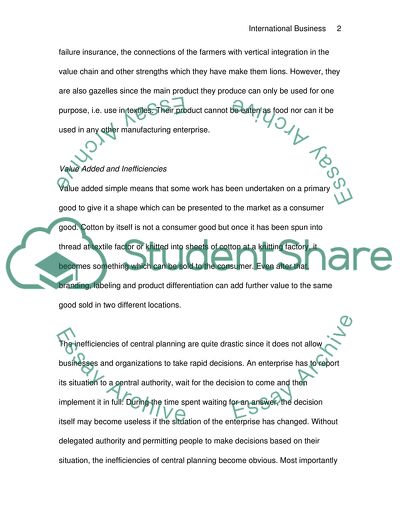
- Home
- Free Samples
- Premium Essays
- Editing Services
- Extra Tools
- Essay Writing Help
- About Us
- Studentshare
- Subjects
- Miscellaneous
- Internatinal Business
Internatinal Business - Essay Example

- Subject: Miscellaneous
- Type: Essay
- Level: Ph.D.
- Pages: 4 (1000 words)
- Downloads: 0
- Author: carley30
Extract of sample "Internatinal Business"
Thus the competition is of speed, strength and stamina between economies which is played out in the international business jungle. American cotton growers come across as being both since they are the hunters as well as the hunted when it comes to the process by which cotton is produced and sold in the world as a commodity. They are lions because America is still amongst the world’s foremost producers of cotton. The economies of scale used by American farmers mean that competition from Mexico, India or Pakistan is no match for the total amount the American farmers can produce.
Further, the subsidies provided by the American government, access to soft credit, crop failure insurance, the connections of the farmers with vertical integration in the value chain and other strengths which they have make them lions. However, they are also gazelles since the main product they produce can only be used for one purpose, i.e. use in textiles. Their product cannot be eaten as food nor can it be used in any other manufacturing enterprise. Value added simple means that some work has been undertaken on a primary good to give it a shape which can be presented to the market as a consumer good.
Cotton by itself is not a consumer good but once it has been spun into thread at textile factor or knitted into sheets of cotton at a knitting factory, it becomes something which can be sold to the consumer. Even after that, branding, labeling and product differentiation can add further value to the same good sold in two different locations. The inefficiencies of central planning are quite drastic since it does not allow businesses and organizations to take rapid decisions. An enterprise has to report its situation to a central authority, wait for the decision to come and then implement it in full.
During the time spent waiting for an answer, the decision itself may become useless if the situation of the enterprise has changed. Without delegated authority and permitting people to
...Download file to see next pages Read MoreCHECK THESE SAMPLES OF Internatinal Business
International Business
International Business
International Business
International Business
Steady Shifts in the World Economy
YOU NEED GIVE A TITLE FOR IT
International business
International Business

- TERMS & CONDITIONS
- PRIVACY POLICY
- COOKIES POLICY